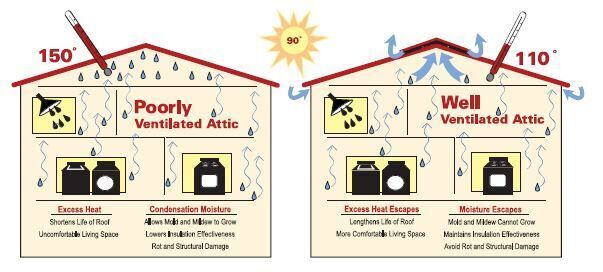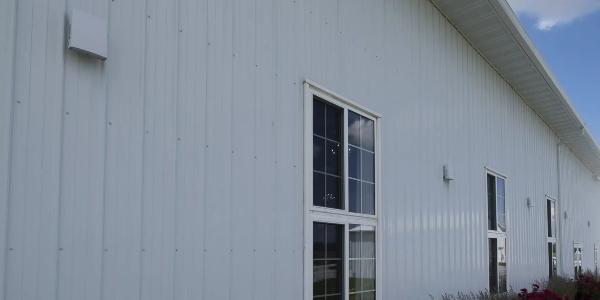Now You See it, Now You Don’t

Attic ventilation choices - dynamic versus static?
By Andy Swan, Roof Saver
The awareness of the importance of adequate and efficient roof ventilation continues to grow, as consumers understand the dangers of moisture build-up and resultant mold growth. The question is no longer, “Should the roofing contractor ventilate the attic,” but “What is the most effective way to ventilate the attic?” Currently, contractors are looking at the difference between static and dynamic ventilation systems.
According to B.R. Stewart’s article, “Attic Ventilation for Homes,” which he published as an agricultural engineer-environmental control – at the Agricultural Extension service of Texas A&M, “Ventilation of the home attic is important for two reasons. During the summer, excess heat that builds up in the attic during the day results in high energy costs for cooling. Also, moisture produced within the home may move into the attic if ceiling vapor barriers are not used. If this moisture is not exhausted from the attic it can condense and cause insulation and construction materials to deteriorate. Thus, temperature and moisture control are the major reasons for providing attic ventilation.”
It is not simply important to ventilate, but to ventilate properly. An attic can easily reach temperatures of 150 – 160 degrees Fahrenheit when the outdoor air temperature is only 90 degrees Fahrenheit. The cooling requirements for the home are increased dramatically. During cooler months the condensation of water occurs as cool outside air comes in contact with warm air and building surfaces inside the attic. Both ventilation systems, static and dynamic, ventilate the attic reducing high temperatures and moisture. They accomplish this result using different methods with varying benefits and drawbacks.
Static ventilation Static ventilation is the use of non-electrical ventilation products that work with the natural flow of warm air and wind movement around the home. The method takes advantage of two principles. First, as air is heated it becomes less dense and rises. Second, wind movement over and around a home creates areas of high and low pressure. If a space has high air outlets in conjunction with low inlets, ventilation occurs as the air within the space is heated. In most cases, the greater the vertical distance between the outlet and inlet, the greater the difference in temperature between the soffit and the ridge which in turn can increase the ventilation rate.
A system of continuous ridge ventilation at the peak of the roof and soffit vents beneath the eaves is a common form of static ventilation. It provides for movement of air throughout the entire attic space. Other forms of static exhaust systems include gable vents in a variety of shapes and are located at the top of the gable. Round turbine vents are often seen perched atop a home and use the wind to draw the air from the attic space but have limited ability to allow the naturally buoyant heated air to escape from the attic.
Gable and turbine vents do not offer continuous airflow through the ridge. Also, the number and location of vents needed should be calculated carefully to make sure that all parts of the attic receive ventilation. With pot or turbine vents, dead spaces can escape ventilation raising the entire temperature of the attic. Another difference between ridge ventilation and the other static vents is appearance. Roofers and builders have an opportunity to maximize the appearance of a home by using low profile ridge vents on the roof and soffit vents hidden beneath the eaves.
Dynamic ventilation Dynamic ventilation is accomplished in two ways. According to Stewart, in homes not mechanically cooled (air-conditioned) the temperature can be controlled to some extent by the use of attic fans. These fans are usually ceiling mounted in a central hallway so that outside air is pulled through open windows and exhausted through the attic. Sufficient outlets should be installed uniformly through the entire attic. Again, it is important to calculate the free air space and the number of vents needed to adequately ventilate the attic.
Dynamic ventilation methods add to the energy use of the home and according to askthebuilder.com, “It turns out that rooftop and sidewall mounted attic fans can actually suck air conditioned air from your house into your attic space. What’s more – in extreme cases – they can actually create serious life safety problems by back drafting combustion gases into a house living space.” The site continues to note a study by the Florida Solar Energy Center that has proven that as the sun heats up the wood roof sheathing and framing members in your attic they quickly and invisibly send this heat directly to the top layer of your attic insulation. The insulation in turn re-radiates this heat into the attic airspace.
Using this example the installation of a continuous ridge vent in conjunction with soffit vents will accommodate the natural rise of the heated air, thereby cooling the attic space while allowing the cool air in the home below to remain. Power ventilation methods tend to suck the cool air from the house with the possibility of also pulling combustion gases into your living spaces. Static ventilation is an efficient way of ventilating the attic without the use of additional energy, plus there is no future maintenance needed. With the entire ridge vented there are also no extra protrusions from the roof while providing a constant means of escape for warm, moist air, keeping the home cool.
Andy Swan is president of Blocksom and Co., manufacturer of Roof Saver Ridge Vent. For more information on Roof Saver visit www.roofsaver.com. Watch this video and fill out the form to try Roof Saver for free.






















Comments
Leave a Reply
Have an account? Login to leave a comment!
Sign In